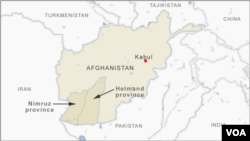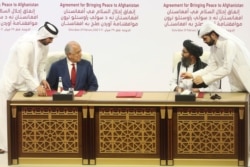Authorities in Afghanistan said Tuesday an intelligence-led security operation had killed a key al-Qaida leader in a western region close to the Iranian border.
The Afghan spy agency, the National Directorate of Security, identified the slain man as Mohammad Hanif, also known as Abdullah, and said he was linked to the terror network’s regional affiliate, al-Qaida in the Indian Subcontinent, or AQIS.
The NDS said Hanif was a citizen of neighboring Pakistan and accused the insurgent Taliban of giving him “a safe haven and protection” in the Afghan province of Farah, where the raid was carried out.
The militant commander also was operating in the nearby provinces of Helmand and Nimruz, providing bomb-making training to Taliban insurgents, the spy agency asserted. The operation also arrested two Pakistani women, the NDS said, but gave no further details, nor did it disclose the date of the raid.
A Taliban spokesman contacted by VOA said the insurgent group was “investigating the issue.”
The presence of an al-Qaida operative in insurgent-held Afghan areas, if confirmed, would be a breach of the peace-building agreement the Islamist Taliban signed with the United States in February.
Afghan security forces last month also announced the killing of a senior al-Qaida leader in the central Ghazni province, where Taliban insurgents control or contest most of the districts. The slain militant commander was on the FBI’s Most Wanted Terrorists list.
A U.S. official who spoke to VOA at that time and on condition of anonymity confirmed the death of al-Qaida’s Abu Muhsin al-Masri, saying U.S. forces provided support during the Afghan-led operation in Ghazni.
The United Nations, in a recent report earlier this year, noted that the Taliban continued to maintain ties with al-Qaida, charges the insurgents vehemently rejected at the time, saying they were aimed at undermining their deal with the U.S.
The February 29 pact binds the insurgents to sever ties with global terror groups, including al-Qaida, and prohibits these terror groups from operating in Afghanistan. In return, the U.S. has committed to stage a “conditions-based” withdrawal of all American and allied troops from the country by May 2021.
Peace talks amid rising hostilities
The document also requires the Taliban to negotiate a permanent cease-fire and political power-sharing deal with representatives of the Afghan government in peace talks currently under way in Qatar.
But even as the two adversaries engage in what are official known as intra-Afghan negotiations, battlefield violence in Afghanistan remains high.
“Unfortunately, not only the promised reduction of violence and comprehensive cease-fire have not been realized, but the violence by the Taliban has increased substantially,” Afghan President Ashraf Ghani told a summit meeting Tuesday of the China-led Shanghai Cooperation Organization, or SCO.
For its part, the Taliban accuses Afghan security forces of launching fresh attacks against insurgent-held areas.
Afghan officials and independent critics, meanwhile, say they are not sure how U.S. President-elect Joe Biden would treat the deal that President Donald Trump’s administration sealed with the Taliban.
While most analysts expect Washington to continue to stick to the peace-making process, Afghan officials have urged Biden to review the deal with the Taliban, saying the Trump administration excluded Kabul from the entire process.
On Tuesday, the Taliban’s formal detailed reaction to Biden’s election victory called on the incoming U.S. leader to stick to the troop withdrawal agreement to ensure the 19-year-old war in Afghanistan is brought to an end.
“The Islamic Emirate [Taliban] would like to stress to the new American president-elect and the future administrations that implementation of the agreement is the most reasonable and effective tool for ending the conflict between both our countries,” the group said.
Trump has been keen to close what has become the longest U.S. war and stated last month he would like to bring home all American troops by Christmas. The Afghan war has cost the lives of more than 2,400 U.S. soldiers and nearly $1 trillion.
VOA’s Jeff Seldin contributed to this report.





